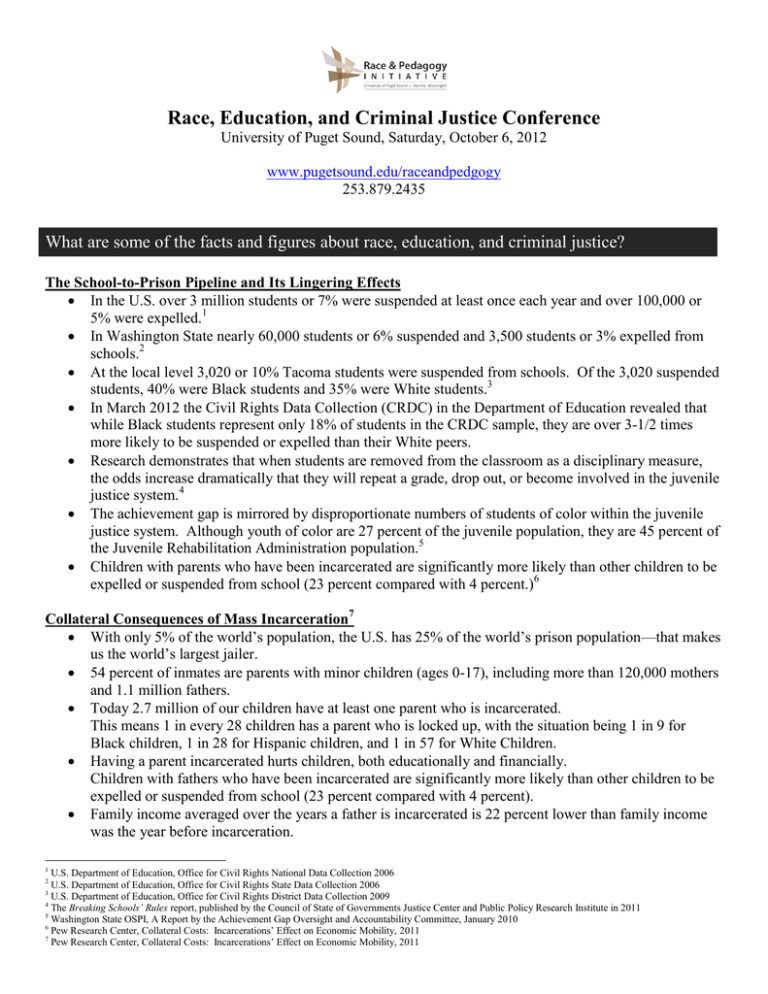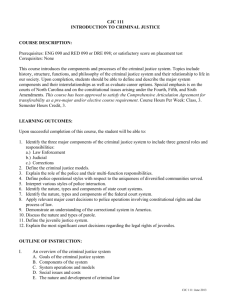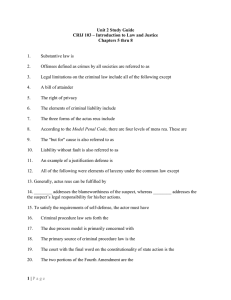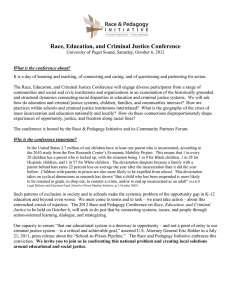Race, Education, and Criminal Justice Conference
advertisement

Race, Education, and Criminal Justice Conference University of Puget Sound, Saturday, October 6, 2012 www.pugetsound.edu/raceandpedgogy 253.879.2435 What are some of the facts and figures about race, education, and criminal justice? The School-to-Prison Pipeline and Its Lingering Effects In the U.S. over 3 million students or 7% were suspended at least once each year and over 100,000 or 5% were expelled.1 In Washington State nearly 60,000 students or 6% suspended and 3,500 students or 3% expelled from schools.2 At the local level 3,020 or 10% Tacoma students were suspended from schools. Of the 3,020 suspended students, 40% were Black students and 35% were White students.3 In March 2012 the Civil Rights Data Collection (CRDC) in the Department of Education revealed that while Black students represent only 18% of students in the CRDC sample, they are over 3-1/2 times more likely to be suspended or expelled than their White peers. Research demonstrates that when students are removed from the classroom as a disciplinary measure, the odds increase dramatically that they will repeat a grade, drop out, or become involved in the juvenile justice system.4 The achievement gap is mirrored by disproportionate numbers of students of color within the juvenile justice system. Although youth of color are 27 percent of the juvenile population, they are 45 percent of the Juvenile Rehabilitation Administration population.5 Children with parents who have been incarcerated are significantly more likely than other children to be expelled or suspended from school (23 percent compared with 4 percent.)6 Collateral Consequences of Mass Incarceration7 With only 5% of the world’s population, the U.S. has 25% of the world’s prison population—that makes us the world’s largest jailer. 54 percent of inmates are parents with minor children (ages 0-17), including more than 120,000 mothers and 1.1 million fathers. Today 2.7 million of our children have at least one parent who is incarcerated. This means 1 in every 28 children has a parent who is locked up, with the situation being 1 in 9 for Black children, 1 in 28 for Hispanic children, and 1 in 57 for White Children. Having a parent incarcerated hurts children, both educationally and financially. Children with fathers who have been incarcerated are significantly more likely than other children to be expelled or suspended from school (23 percent compared with 4 percent). Family income averaged over the years a father is incarcerated is 22 percent lower than family income was the year before incarceration. 1 U.S. Department of Education, Office for Civil Rights National Data Collection 2006 U.S. Department of Education, Office for Civil Rights State Data Collection 2006 3 U.S. Department of Education, Office for Civil Rights District Data Collection 2009 4 The Breaking Schools’ Rules report, published by the Council of State of Governments Justice Center and Public Policy Research Institute in 2011 5 Washington State OSPI, A Report by the Achievement Gap Oversight and Accountability Committee, January 2010 6 Pew Research Center, Collateral Costs: Incarcerations’ Effect on Economic Mobility, 2011 7 Pew Research Center, Collateral Costs: Incarcerations’ Effect on Economic Mobility, 2011 2 Race and Washington’s Criminal Justice System8 The fact of racial and ethnic disproportionality in Washington’s incarcerated population is indisputable. Blacks are incarcerated at 6.4 times and Latinos at 1.3 times the rate of Whites. Black incarceration rate is greater than the national average. A study of probation officers’ assessment of youth in Washington State has found that African American youth receive more negative attribution assessments about the causes of their offenses than White youth and these characterizations lead to more punitive sentence recommendations. Youth of color in Washington State are disproportionately overrepresented in juvenile sentencing. In 2009, African American youth comprised just over four percent of the State’s population, but received over 15 percent of juvenile dispositions. A similar pattern also occurred for Latino youth with eleven percent of the State population, but received fourteen percent of juvenile dispositions. Our democracy is based on the rule of law and faith in the fairness of the justice system. This faith is undermined by disparity and by high profile incidents of violence toward people of color by law enforcement. The problem is not a “people of color” problem. It is our problem as a society to address. Education and Recidivism Education for current and former prisoners is a cost-effective solution to reducing reoffending and improving public safety. National studies showed that college classes cut recidivism by 30% or more. That would make a good investment for state taxpayers.9 It is estimated that for every dollar invested in education society gets about $7 in return as measured by the fact that the educated person will be a consumer and taxpayer and a corresponding reduction in the cost of the criminal justice system.10 Those who have spent time in prison earn 40 percent less annually. Most unsettling is the fact that more than half of those incarcerated were the primary financial providers for their children.11 Today, nearly 10 percent of U.S. prisons and jails have been privatized. The federal government also contracts with private companies to house a growing number of undocumented immigrants and resident aliens.12 Race, Education, and Criminal Justice Conference University of Puget Sound, Saturday, October 6, 2012 www.pugetsound.edu/raceandpedgogy 253.879.2435 Preliminary Report on Race and Washington’s Criminal Justice System, A Publication by the Task Force on Race & Criminal Justice System, 2011 Correctional Education Association Special Interest Group, “The Effects of Prison Education on Recidivism,” by Jerry Bednarowski, 03/12/2011 10 Center for Juvenile and Criminal Justice, “Education as Crime Prevention,” by Randall G. Shelden, 04/01/2011 11 www.criminaljusticeusa.com/blog/2011/10-stats-you-should-know-about-our-prison-system/ 12 Black Education for Liberation, www.blackeducator.org/blackprisonusa.htm 8 9



